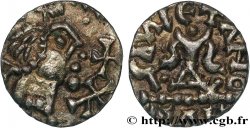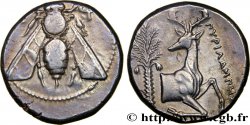Live auction - bmv_948579 - MEROWINGISCHEN MÜNZEN - BANASSAC (BANNACIACO) - Lozere Denier
Sie müssen angeschlossen sein und von cgb.fr genehmigt werden, um in einer E-Auktion teilzunehmen.Melden Sie sich an, um zu wetten..Die Kontobestätigungen sind innerhalb von 48 Stunden nach Ihrer Anmeldung gemacht.Warten Sie nicht bis die letzten zwei Tage vor dem Abschluss eines Verkaufs, um Ihre Registrierung abzuschließen. Klickend "BIETEN" verpflichten Sie sich vertraglich, diesen Artikel zu kaufen und Sie nehmen ohne Reserve die allgemeinen Verkaufsbedingungen für den live auctions zu cgb.fr an.
Der Verkauf wird an der Zeit auf der Übersichtsseite angezeigt geschlossen werden. Angebote, die nach der Schließung Zeit empfangen sind, werden nicht gültig.
Bitte beachten Sie, dass die Fristen für die Einreichung Ihres Angebots auf unsere Server können variieren und es kann zur Ablehnung Ihres Angebots entstehen, wenn es in den letzten Sekunden des Verkaufs gesendet wird. Die Angebote sollen mit ganzer Zahl ausgeführt sein, Sie können Kommas oder des Punktes in Ihrem Angebot nicht erfassen. Bei Fragen klicken Sie hier, um einen Blick auf die FAQ Live-Auktionen.
Alle Gewinngebote unterliegen einem Aufschlag von 18 % für Verkaufskosten.
Alle Gewinngebote unterliegen einem Aufschlag von 18 % für Verkaufskosten.
| Schätzung : | 1 200 € |
| Preis : | Kein Gebot |
| Höchstgebot : | Kein Gebot |
| Verkaufsende : | 24 September 2024 15:56:29 |
Type : Denier
Datum: (VIIe-VIIIe siècles)
Datum: s.m.
Name der Münzstätte / Stadt : Banassac
Metall : Silber
Durchmesser : 12 mm
Stempelstellung : 3 h.
Gewicht : 1,13 g.
Seltenheitsgrad : R3
Kommentare zum Erhaltungszustand:
Denier frappé sur un flan irrégulier et un peu court. Hauts reliefs. Patine grise
N° im Nachschlagewerk :
Pedigree :
Monnaie provenant de la collection Philippe Schiesser
Vorderseite
Beschreibung Vorderseite Calice à deux anses ou mitre stylisée (?), surmonté d’une croixet.
Rückseite
Titulatur der Rückseite A, K, W, A.
Beschreibung Rückseite Croix aux bras bifides, une lettre dans chaque canton.
Kommentare
Le calice, typique du monnayage d’argent de Banassac, est différent sur ce denier par rapport à ceux du Belfort, par exemple. Pour ce type, toutes variétés confondues, G. Depeyot n’a répertorié que neuf exemplaires ; les trois du Belfort, trois de la vente Cahn 1932, deux du trésor de Saint-Pierre-les Etieux et un du trésor de Bais. Un dixième exemplaire est aussi classé à Banassac à cause du calice, mais d’un tout autre type (cf. B. 5757).
Au revers, les lettres A et Z sont relativement nettes dans les 3e et 4e cantons de la croix, mais les lettres dans les deux premiers cantons sont difficiles à identifier. D’après les monnaies n° 774 à 777 du Belfort, il devrait s’agir de RA-G ou LA. Les lettres RAG ont fait attribuer ces deniers à Ragenfrid, mais A. de Belfort les restitue à Banassac en raison des analogies avec les monnaies d’or au calice.
Seulement sur l’exemplaire proposé ici, l’analogie n’est pas du tout évidente et les lettres semblent plutôt être E (rétrograde) au premier canton et D au deuxième canton !
Bien qu’aucune autre monnaie d’argent s’en approchant ne semble être publiée, il est permis de douter de la parenté de ce denier avec les monnaies traditionnellement attribuées à Banassac ?.
The chalice, typical of the silver coinage of Banassac, is different on this denarius compared to those of Belfort, for example.. For this type, all varieties combined, G. Depeyot only listed nine examples; the three from Belfort, three from the 1932 Cahn sale, two from the Saint-Pierre-les-Etieux treasure and one from the Bais treasure.. A tenth example is also classified in Banassac because of the chalice, but of a completely different type (cf.. B. 5757).
On the reverse, the letters A and Z are relatively clear in the 3rd and 4th cantons of the cross, but the letters in the first two cantons are difficult to identify. According to coins no. 774 to 777 from Belfort, it should be RA-G or LA. The letters RAG have attributed these coins to Ragenfrid, but A. Belfort returned them to Banassac because of the similarities with the gold coins with the chalice.
Only on the example proposed here, the analogy is not at all obvious and the letters seem rather to be E (retrograde) in the first canton and D in the second canton! Although no other silver coin approaching it seems to be published, it is permissible to doubt the relationship of this denier with the coins traditionally attributed to Banassac?
Au revers, les lettres A et Z sont relativement nettes dans les 3e et 4e cantons de la croix, mais les lettres dans les deux premiers cantons sont difficiles à identifier. D’après les monnaies n° 774 à 777 du Belfort, il devrait s’agir de RA-G ou LA. Les lettres RAG ont fait attribuer ces deniers à Ragenfrid, mais A. de Belfort les restitue à Banassac en raison des analogies avec les monnaies d’or au calice.
Seulement sur l’exemplaire proposé ici, l’analogie n’est pas du tout évidente et les lettres semblent plutôt être E (rétrograde) au premier canton et D au deuxième canton !
Bien qu’aucune autre monnaie d’argent s’en approchant ne semble être publiée, il est permis de douter de la parenté de ce denier avec les monnaies traditionnellement attribuées à Banassac ?.
The chalice, typical of the silver coinage of Banassac, is different on this denarius compared to those of Belfort, for example.. For this type, all varieties combined, G. Depeyot only listed nine examples; the three from Belfort, three from the 1932 Cahn sale, two from the Saint-Pierre-les-Etieux treasure and one from the Bais treasure.. A tenth example is also classified in Banassac because of the chalice, but of a completely different type (cf.. B. 5757).
On the reverse, the letters A and Z are relatively clear in the 3rd and 4th cantons of the cross, but the letters in the first two cantons are difficult to identify. According to coins no. 774 to 777 from Belfort, it should be RA-G or LA. The letters RAG have attributed these coins to Ragenfrid, but A. Belfort returned them to Banassac because of the similarities with the gold coins with the chalice.
Only on the example proposed here, the analogy is not at all obvious and the letters seem rather to be E (retrograde) in the first canton and D in the second canton! Although no other silver coin approaching it seems to be published, it is permissible to doubt the relationship of this denier with the coins traditionally attributed to Banassac?








 Berichten über einen Fehler
Berichten über einen Fehler Die Seite drucken
Die Seite drucken Teilen meiner Auswahl
Teilen meiner Auswahl Stellen Sie eine Frage
Stellen Sie eine Frage Einlieferung/Verkauf
Einlieferung/Verkauf
 Details
Details












